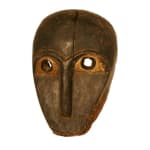Baule Monkey Mask, 20th Century CE
Wood
5.75 x 9
SP.650 (LSO)
This hypnotic facemask was made by the Baule, the most powerful tribe in the Ivory Coast and among Africa’s greatest artistic creators. Monkey masks are intimately associated with the Baule,...
This hypnotic facemask was made by the Baule, the most powerful tribe in the Ivory Coast and among Africa’s greatest artistic creators. Monkey masks are intimately associated with the Baule, and indeed other representations of monkeys regularly appear in their artistic repertoire. Notable among these is the skeletal gbreke monkey, which is associated with blacksmiths, defence of the village, and is sacrificed to by pouring the blood of a dog over it. This piece is far more harmonious, being of simple round-top-pointed-chin design, and a T-bar arrangement of eyebrows and nose. The mouth is basically absent. The eyes are pierced and are marked around with kaolin. The surface is patinated and the wood is well weathered with age and handling.
The Baule live across the Ivory Coast area, and have an economy based primarily on sedentary agriculturism. They have thus been able to build up a considerable political and economic stronghold, which has in turn given rise to a strong ritual and artistic heritage. Their own creation story relates to an ancient migration, in which the queen was forced to sacrifice her son in order to ford a mighty river. So upset was she that all she could say was “baouli” (the child is dead), thus giving rise to the tribe’s name.
Blolo bian (male) and Blolo bla (female) spirit spouses are perhaps the Baule’s greatest artistic and psycho-social achievement, but they are also renowned for sculptures representing bush spirits (Asie usu) (mischievous and potentially malevolent inhabitants of the “bush” or dark country beyond the boundary of the village). They are also known for their masks, which have a range of diplomatic and ritual functions. Monkeys are usually viewed as mischievous, bright and amusing, and it is probable that this is a masquerade piece designed to represent some such character.
Like most other human societies, the Baule are prey to conspicuous consumption, which is a central key to asserting ones status in the village, and thus ones power and influence. While their carving is among the most refined and restrained in Africa, therefore, artists vie to produce more impressive and beautiful carvings which are often decorated or adorned by their proud owners. This is a charming piece of African art.
The Baule live across the Ivory Coast area, and have an economy based primarily on sedentary agriculturism. They have thus been able to build up a considerable political and economic stronghold, which has in turn given rise to a strong ritual and artistic heritage. Their own creation story relates to an ancient migration, in which the queen was forced to sacrifice her son in order to ford a mighty river. So upset was she that all she could say was “baouli” (the child is dead), thus giving rise to the tribe’s name.
Blolo bian (male) and Blolo bla (female) spirit spouses are perhaps the Baule’s greatest artistic and psycho-social achievement, but they are also renowned for sculptures representing bush spirits (Asie usu) (mischievous and potentially malevolent inhabitants of the “bush” or dark country beyond the boundary of the village). They are also known for their masks, which have a range of diplomatic and ritual functions. Monkeys are usually viewed as mischievous, bright and amusing, and it is probable that this is a masquerade piece designed to represent some such character.
Like most other human societies, the Baule are prey to conspicuous consumption, which is a central key to asserting ones status in the village, and thus ones power and influence. While their carving is among the most refined and restrained in Africa, therefore, artists vie to produce more impressive and beautiful carvings which are often decorated or adorned by their proud owners. This is a charming piece of African art.



